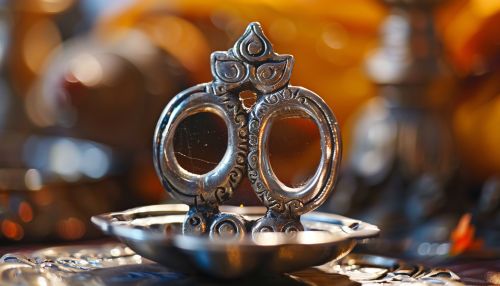Brahman
Overview
Brahman is a key concept in Hinduism, representing the ultimate reality or supreme cosmic power in the universe. It is an abstract, impersonal absolute, beyond human comprehension and described as infinite, eternal truth and bliss which does not change, yet is the cause of all changes. Brahman is the source of all things and is in all things; it is the Self (Atman) of all living beings.
Etymology and Definitions
The term Brahman is derived from the Sanskrit root brh, meaning "to grow", and brh or brm, meaning "to expand, swell, or enlarge". The Vedic Samhitas, the earliest Hindu scriptures, use the term to denote prayers and sacrificial formulas, while the Brahmanas, a group of ancient Indian texts, use it to refer to the power of the spoken word and the cosmic principle underlying these rituals.
Concept
Brahman is the foundational concept in Hindu philosophy, representing the ultimate reality or absolute truth. It is beyond human comprehension, beyond words and thought, and is often described as neti neti (not this, not this) to signify its indescribable nature. It is not an object of knowledge but is the very essence of consciousness itself.
Brahman in the Upanishads
The concept of Brahman is extensively discussed in the Upanishads, a collection of ancient Hindu philosophical texts. The Upanishads describe Brahman as the eternal, conscious, irreducible, infinite, omnipresent, spiritual source of the universe of finiteness and change.
Brahman and Atman
In Hindu philosophy, the individual self or soul is known as Atman. The Upanishads identify the individual soul Atman with the universal Brahman, suggesting that they are one and the same. This identification of Atman and Brahman is a central theme in Hindu philosophy and is known as the doctrine of Atman-Brahman unity.
Brahman in Various Schools of Hindu Philosophy
Different schools of Hindu philosophy interpret the concept of Brahman differently. The Advaita Vedanta school posits that Brahman is the only reality, and all else is illusion (Maya). The Dvaita Vedanta school, on the other hand, maintains a dualistic interpretation, viewing Brahman and the world as distinct. The Vishishtadvaita Vedanta school proposes a qualified monism, where Brahman is the absolute reality, but the individual souls and the material world are also real, though dependent on Brahman.
Brahman in Hindu Rituals
In Hindu rituals, Brahman is invoked and worshipped in various forms. The rituals are seen as a means to realize Brahman, to experience the oneness of the individual soul (Atman) with the universal Brahman.
Brahman in Hindu Art and Iconography
In Hindu art and iconography, Brahman is often symbolically represented. For example, the sacred syllable Om is considered a symbol of Brahman.
See Also


